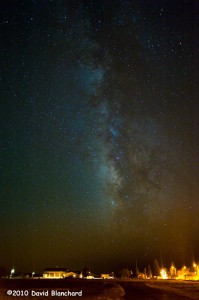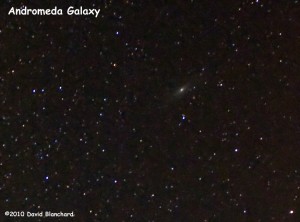I have been having a lot of fun taking sky images lately. The newer DSLR cameras (and especially the full-frame cameras) can really push the ISO settings making it easier to take astronomy images with short exposures. The short exposure limits the trails that the stars will make and gives an overall sharper appearance.
This image was shot at ISO 6400, 15s, f/4.0, 28mm focal length. At full zoom, there is only a hint of star trails.

The lights along the horizon add interesting texture to the image but even though they were fairly dim the 15s exposure resulted in far too much brightening. After experimenting a bit, I decided to place a credit card in front of the lens blocking the street lights for about 12-13s, then pull it away for the last few seconds. Overall, it did a pretty good job attenuating the street lights but there is also a dark area in the sky just above the lights.
What I should do is get a better neutral density gradient filter that I can slide up and down rather than the screw-on filter that I have now. Then I wouldn’t have to resort to credit card tricks!
Here is another example of what modern DSLR cameras can do. This was taken with the same settings as the image above. Even with a 28-mm wide angle lens, the camera is able to resolve the Andromeda Galaxy which is over 2.5 million light years distant.
